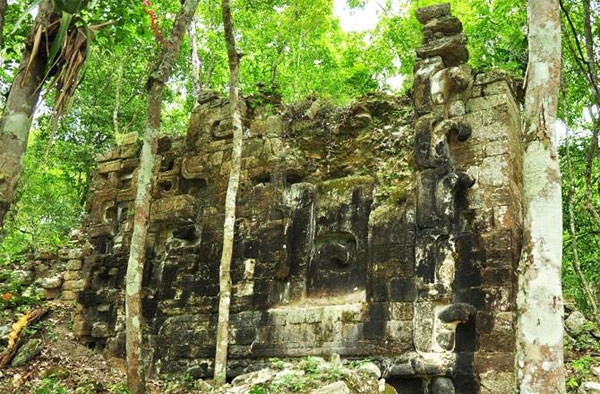Discover the ancient Mayan city in the forest
A door shaped like a monster's mouth, ruined pyramid temples and ancient Mayan palace ruins, unearthed in a dense forest in Mexico.
>>>Found ancient Mayan city in Mexican forest
The remnants of the ancient Mayan city are found in the jungle of the center of the Yucatan Peninsula, southeast of Campeche, Mexico, where the human population is almost as thick and nearly inaccessible. follow News Discovery.
"Satellite images help us locate the exact locations ," said Ivan Sprajc, the expedition team leader of the Slovenian Institute of Arts and Sciences (ZRC SAZU).
The discovery site spans nearly 4,600 km 2 , between the areas of Rio Bec and Chenes, both known for their distinctive architectural style in the early classic period until the end of the classic, around 600-1000 years after the Public original. One of the characteristics of the city is the entrance to the façade shaped like a monster's mouth on earth.

The door has a stylized monster's mouth with fangs along the door frame.(Photo: Ivan Sprajc / Discovery)
This place was previously known since the 1970s by archaeologist Eric Von Euw, USA. He spotted some steles and left some unpublished drawings. However, the exact location of the ancient Mayan city he called Lagunita is still very mysterious.
"The information about Lagunita is vague and completely useless , " Sprajc told Discovery News.
After the discovery this time, archaeologists identified the Laguinita city position after comparing it with the new facade, the remains with the previous drawing of Von Euw.
'The door is shaped like a monster mouth representing a Mayan deity related to fertility. It also symbolizes the entrance to a cave leading to the afterlife or to the ancestral residence , ' Sprajc said.
The team found remains in a number of large palaces, a temple tower of nearly 20m high, 10 stone steles, three altars made of low round stone, reliefs carved in hieroglyphs. According to the preliminary content translated by Octavio Esparza Olguin from the National University of Mexico, one of the steles was engraved on November 29, 711, and unfortunately the remaining documents, including the name of the ruler and his wife were erosion should be unreadable.
In addition to the city of Laguinita, another city was discovered, and was named Tamchen by the research team, meaning 'Deep well'. Here, there are about 30 underground tunnels used to catch rainwater, one of them is nearly 13m deep.
Like in Laguinita, the commercial center is surrounded by large buildings. Tamchen covers the rest of a courtyard with three temples on its sides, a pyramid temple, a stele and an altar.
'Two cities suggest new questions about the Mayan cultural diversity, the role of archaeological sites is largely unexplored in Mayan history ,' Sprajc said.
- Found ancient Mayan city in Mexican forest
- Discover the ancient Mayan city hidden under Guatemala old forest
- Discover the largest Mayan dam
- Mysterious beam of light on top of the Mayan pyramid
- Uxmal City: Ancient Mayan civilization is still unknown
- The 15-year-old boy found the ancient city of Maya in the jungle
- Detect tremors about Pacal the Great Mayan
- Discover the secret behind the Mayan's
- The underworld and continually sacrificed 'cold' Mayan people
- Discover an ancient city in the middle of the Pacific Ocean
- Explore ancient Mayan residences
- The Mayan calendar never mentioned the end of the world
 Discovered an ancient centipede fossil 99 million years old
Discovered an ancient centipede fossil 99 million years old Discovered bat-like dinosaurs in China
Discovered bat-like dinosaurs in China Discovered a 200-year-old bronze cannon of the coast
Discovered a 200-year-old bronze cannon of the coast Discover 305 million-year-old spider fossils
Discover 305 million-year-old spider fossils